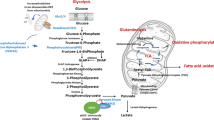Abstract
Cultures of endothelial cells and cell lines of endothelial origin were maintained at confluence without medium exchange for a period of 72 h. During this time period the concentration of nutrients — amino acids and glucose — and metabolic waste products — lactate and ammonium — was determined as well as cell vitality and cell numbers. Metabolic rates were calculated and compared for the different cell lines. Surprisingly the primary cells showed significantly higher rates of glucose and glutamine consumption, respectively lactate production than the immortalized cell lines. Except for one tumorigenic cell line all cells showed a significant participation of transaminases in glutamine/ammonium metabolism. Furthermore it could be shown that in routine culture there was no depletion of nutrients or critical accumulation of ammonium or lactate over a culture period of 72 h.
Similar content being viewed by others
Abbreviations
- BAEC:
-
bovine aorta endothelial cells
- EC:
-
vascular endothelial cells
- FGF:
-
fibroblast growth factor
- HUVEC:
-
vascular endothelial cells from human umbilical cord veins
- IF:
-
1:1 mixture of Iscove's MDM and Ham's F12 basal media
- MTT:
-
3-(4,5-dimethylthiazol-2-yl)-2,5-diphenyltetrazoliumbromid
- NCS:
-
newborn calf serum
- PBS:
-
phosphate buffered saline
- TE:
-
0.05% (w/V) trypsin, 0.02% (w/v) EDTA in PBS
References
Engerman RL, Pfaffenbach D & Davis MD (1967) Cell turnover of capillaries. Lab. Invest. 17: 738–742.
Edgell CJS, McDonald CC and Graham JB (1983) Permanent cell line expressing human factor VIII related antigen established by hybridisation. Proc. Natl. Acad. Sci. USA 80: 3734–3737.
Friedl P, Tatje D and Czapla R (1989a) An optimized culture medium for human vascular endothelial cells from umbilical cord veins. Cytotechnology 2: 171–179.
Friedl P, Chang JJ, Czapla R and Tatje D (1989b) Different oxygen sensitivities of vascular endothelial cells from porcine aorta and from human umbilical cord veins during fermentation in a stirred bioreactor. In “Advances in animal cell biology and technology for bioprocesses” ESACT pp 233–237, Butterworth Pub, Essex.
Friedl P & Tatje D (1989c) Optimizing the conditions for the fermentation of human umbilical cord vein endothelial cells. In “Advances in animal cell biology and technology for bioprocesses” ESACT pp 398–403, Butterworth Pub, Essex.
Friedl P, Chang JJ and Czapla RR (1990) Determination of endothelial cell growth on microcarriers by various methods. Biotechnol. Techn. 4: 243–248.
Gimbrone MA, Shefton EJ and Cruise SA (1978) Isolation and primary culture of endothelial cells from human umbilical vessels. Tissue Culture Association Manual 4: 813–817.
Gorfien S, Spector A, DeLuca L, Weiss S (1993) Growth and physiological functions of vascular endothelial cells in a new serum-free medium (SFM). Exp. Cell. Res. 206: 291–301.
Grinspan JB, Mueller SN & Levine EM (1983) Bovine endothelial cells transformedin vitro by benzo(a)pyrene. J. Cell. Physiol. 114: 328–338.
Jerg R, Baumann H, Keller R and Griedl P (1989) Fermentation of bovine endothelial cells for preparation of endothelial cell surface heparan sulfate. Int. J. Biol. Macromol. 12: 153–157.
Knedler A, Ham RG (1987) Optimized Medium for Clonal growth of Human Microvascular Endothelial Cells with Minimal serumIn Vitro. Cellular & Developmental Biology 23: 481–491.
Kjellström BT, Örtenwall P & Risberg B (1987) Comparison of oxidative metabolismin vitro in endothelial cells from different species and vessels. J. Cell. Physiol. 132: 578–580.
Leighton B, Curi R, Hussein A & Newsholme E.A. (1987) Maximun activities of some key enzymes of glycolysis, glutaminolysis Krebs cycle and fatty acid utilization in bovine pulmonary endothelial cells. FEBS-Lett. 255: 93–96.
Mosman T (1983) Rapid colorimetric assay for cellular growth and survical: application to proliferation and cytotoxicity assays. J. Immunol. Meth. 65: 55–63.
Newsholme EA, Crabtree B & Ardawi MSM (1985) The role of high rates of glycolysis and glutamine utilization in rapidly dividing cells. Bioscience Rep. 5: 393–98.
Reitzer L, Wice BM & Kennell D (1979) Evidence that glutamate, not sugar, is the major energy source for cultured HeLa cells. J. Biol. Chem. 254: 2669–2673.
Schrimpf G & Friedl P (1993) Growth of vascular endothelial cells on various types of microcarriers Cytotechnology 13: 203–211.
Sunada H, Masuda M & Fujiwara K (1993) Preservation of differentiated phenotypes in culture aortic endothelial cells by malotilate and phosphoascorbic acid. Eur. J. Cell. Biol. 60: 48–56.
Takahashi K, Sawasiki Y, Hata JI, Mukai K & Goto T (1990) Spontaneous transformation and immortalization of human endothelial cells.In Vitro Cell. Dev. Biol. 25: 265–274.
Wagner R, Ryll T, Krafft H & Lehmenn J (1988) Variation of amino acid concentrations in the medium of hu-β-IFN- and hu IL2-producing cell lines. Cytotechnology 1: 145–150.
Author information
Authors and Affiliations
Rights and permissions
About this article
Cite this article
Schrimpf, G., Schröder, M., Weitnauer, E. et al. Metabolic rates of vascular endothelial cellsin vitro . Cytotechnology 16, 43–50 (1994). https://doi.org/10.1007/BF00761778
Received:
Accepted:
Issue Date:
DOI: https://doi.org/10.1007/BF00761778




